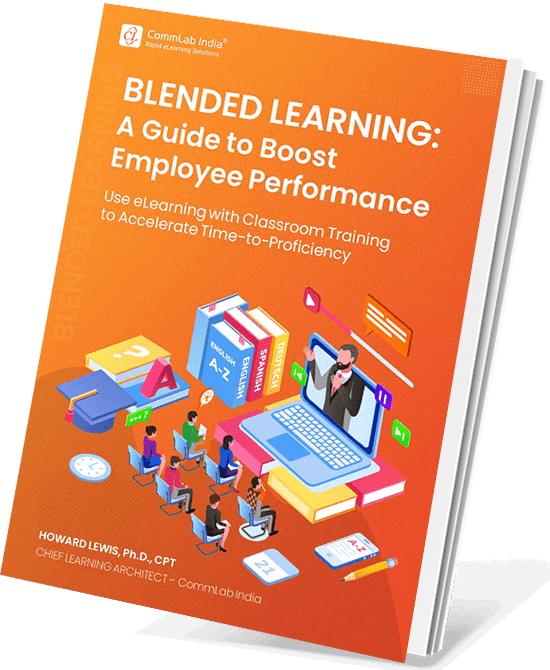How to Create a Facilitator Guide for an Instructor-led Training (ILT) Program?

Have you ever had the experience of facilitating a program that you didn’t have any experience in designing or developing? What information could you provide to that person, so that they could successfully facilitate your learning activity as you have designed it? Instructor-led Training programs require the concordance of the learner and the instructor. Instructional designers satisfy two audiences while designing an Instructor-led Training program. First is the facilitator and second is the participant. In this blog, we’ll focus on how to design a facilitator or instructor guide.
→ Download Now: Blended Learning — A Guide to Boost Employee Performance
Table of Contents
- What Is Instructor-Led Training?
- What Are the Dos and Don’ts for Effective Classroom Presentation Skills?
- How to Create a Facilitator Guide for an ILT Program?
- How to Create an ILT Program with Existing Inputs?
- How Can eLearning Support Classroom (ILT) Training?
What Is Instructor-Led Training?
Instructor-Led Training (ILT) is a traditional method of training where an instructor facilitates learning for a group of individuals or even one-on-one. This can happen in person or virtually through platforms like video conferencing.
Wondering What Are the Key Characteristics of ILT?
Here’s a look:
- Real-time interaction: Learners can ask questions and receive immediate feedback.
- Instructor expertise: The instructor brings knowledge and experience to the training.
- Flexible delivery: Can be adapted to the specific needs of the learners.
- Opportunities for collaboration: Learners can interact with each other and learn from peers.
What Are the Dos and Don’ts for Effective Classroom Presentation Skills?
At times even the experts in their field fail to captivate the attention of their audience in the Instructor-led Training (ILT) sessions. If you’re wondering why, it’s because they lack effective presentation skills — the skills needed to present the training material in an engaging and impactful manner. Therefore, as a facilitator for ILT sessions, it is very important to develop and polish your presentation skills to turn your classroom training sessions into interesting, engaging, and positive learning experiences.
Curious to know what the effective classroom presentation skills are and how can you enhance your Instructor-led Training delivery? Well, here is an infographic that highlights the dos and don’ts of effective ILT presentation skills.
How to Create a Facilitator Guide for an ILT Program?
A well-structured facilitator guide is essential for delivering consistent and effective Instructor-led Training (ILT) programs. It serves as a comprehensive roadmap for trainers, ensuring they have all the necessary information to conduct successful training sessions. It is important to note that an instructional designer plays a key role in creating a facilitator guide as he/she provides instruction and relevant information to the facilitator on what all needs to be covered in the training program. A facilitator requires detailed information, both on content and organizational information.
While curating the facilitator guide, it’s important for instructional designers to focus on the participants/learners aspect as well. In the facilitator guide, they should clearly state that instructors should prioritize the needs of the participants and minimize providing in-depth background information about a topic. Instead, the focus should be on learners being able to apply the knowledge that they have gained during the ILT session. While this information should be very basic and not limiting, instructional designers can suggest activities and assets that ensure a balance between knowledge and application.

The facilitator training guide should include detailed information on the content of the program with step-by-step instructions. To do so, a good instructional designer must put himself/herself in the shoes of the instructor and visualize how the facilitator will present the training materials. This practice helps instructional designers in designing a facilitator guide in an efficient way. It also ensures that the facilitator successfully delivers the information to learners for maximum effectiveness of the ILT program. So without a doubt, the clearer the information is provided in the facilitator guide, the better it will be received by both the facilitator and the learner.
They must clearly state in the guide how the knowledge acquired in the training session is expected to be applied by the learners to improve their performance and efficiency at work.

Blended Learning: A Guide to Boost Employee Performance
Explore the Best Way to Upskill and Reskill Employees!
- Identify core components of blended learning solutions
- Analyze Job Task Inventory Matrix for insights
- Design optimal blended learning solutions
- And More!
Tips to Provide Information on Administrative Content
The instructional designer must provide directions to use the facilitator guide. It includes:
1. List all the items required to conduct the ILT program
2. Offer suggested training methods, activities to present topics (Use of Flip Charts, projector, chalkboard, etc.)
3. Provide participant guide page numbers (if necessary)
4. Provide suggested timelines for each topic that is being presented
Tips to Provide Details About the Course Content
The instructional designer must provide as much information as possible about the subject or training topic so that the facilitator is able to respond to participant questions in a satisfactory manner. For this, the facilitator guide must include:
1. Background information about the Instructor-led Training program
2. Purpose of the ILT program
3. Overall objectives of the program
4. Agenda of the ILT program
5. Key points to emphasize in the training content
6. Reference materials (if available)
Designing materials for Instructor-led Training requires attention from both the facilitator and the learner. By understanding the principles of instructional design, one can easily design facilitator guides for any Instructor-led Training programs.

Blended Learning: A Guide to Boost Employee Performance
Explore the Best Way to Upskill and Reskill Employees!
- Identify core components of blended learning solutions
- Analyze Job Task Inventory Matrix for insights
- Design optimal blended learning solutions
- And More!
How to Create an ILT Program with Existing Inputs?
Imagine a scenario: As an eLearning developer, you have been asked by your manager to design an Instructor-led Training (ILT) program for a client. The condition is that the training has to be comprehensive and must be designed using the existing material so that trainees have good learning experience. More so, you also have to ensure that the ILT program is interactive and engaging so that the learners are actively involved throughout the training process.
Sounds like a pretty tall order. Isn’t it? How do you ensure that the ILT is designed as per the client’s requirements and is appealing to learners? Before you begin to worry, breathe!
Because we did something similar for one of our clients (a contract research organization for drug development) and we will share our raw, first-hand experience about the same and let you in on our secrets of creating a successful ILT program.
Are you ready for the key takeaways? Let’s begin!
So we had to create an ILT program for new hire training where new recruits would learn about the organization. It included common induction training, knowledge of the business verticals of the organization, and role-based training. We received inputs related to the training program in the form of PPTs, PDFs, Word documents, and other printed material.
This is the brief background of how we started with the project. Now let’s take a closer look at the subsequent steps we followed to create the ILT program.
1. Analyzing the Content
As a first step, we analyzed the content which were the inputs sent by the client. This is an important step to understand the content of the training and what it intends for employees to learn about. Content comprehension provides an opportunity to identify gaps in the content and jot down the inputs and clarifications needed from the client.
In subsequent meetings with the client (which can be online), these doubts and clarifications can be solved and the expectations for the project from both sides decided and documented.
This discussion makes it easy to set the scope of the training session – the training format to be used and the duration of the session. At the end of this process, the scope document is signed and formal work on the project starts.
2. Content Chunking
After deciding on the learning objectives and creating a broad outline of the training session in tandem with the client, the next step is to chunk the content to give it a logical structure to fit the course. For this project, since the content was already given and most of it was in the form of PPTs, we found it easy to structure the content in a logical flow.
Content chunking essentially involves analyzing the content to define topic themes and identify topic hierarchies. This will help break down the strings of information into units of content. Once the learning objectives are decided, it becomes easy to choose the content that will cover each objective. It also helps in finding gaps in the content that have to be filled either with further research or by asking for inputs from the SME or client.
3. Coordinating with SMEs
Filling the gaps in the content may require the help of a Subject Matter Expert (SME) who will provide the right inputs. The SME’s inputs will also help when you design interactivities for the session. Activities are a must in ILT sessions as they help keep the audience attentive and engaged.
SMEs will also help you in identifying the job aids and handouts you need to develop to assist learners and this will help you add content that is not included in the course but which the SME feels the learner needs to know.
4. Developing the Course
Once the content and activities are finalized, it is time to develop the course. The whole session was planned – the time for each presentation including the introductions, activities, discussions, knowledge checks, and even the breaks during the session. Fixing the content for each session helped design the related facilitator and participant guides that are integral to an ILT program.
The ready-made bank of content provided by the client made it easy to create the training content for the ILT project. There were still revisions, multiple versions, and clarifications with the client before the content could be finalized.
Note: Creating an ILT program with available inputs follows the same process as that of developing an eLearning course, though the final product is different.

Blended Learning: A Guide to Boost Employee Performance
Explore the Best Way to Upskill and Reskill Employees!
- Identify core components of blended learning solutions
- Analyze Job Task Inventory Matrix for insights
- Design optimal blended learning solutions
- And More!
How Can eLearning Support ILT?
Everything new doesn’t replace the old. In fact, it doesn’t have to be that way all the time. As far as corporate training is concerned, Instructor-led Training (ILT) is by far the best training method after hands-on training. But considering the digital advancement in today’s world, relying solely on a single offline approach can prove detrimental for employee growth and development as well as organizational success. Therefore, eLearning has taken the corporate training world by storm. Many successful organizations are now supplementing their Instructor-led Training (ILT) programs with eLearning. And why not? eLearning offers a plethora of benefits.

Organizations are blending eLearning with ILT to get the best out of their training investments. Here are some of the most effective areas where you can leverage blended learning for maximizing the effectiveness of your ILT program.
1. Training Need Analysis
eLearning can be used for training needs analysis (TNA) of your workforce. Learners can be given a pre-test on a subject and based on their scores, their training needs can be identified. Then, relevant courses can be assigned based on these training needs.
Watch this video to gain a thorough understanding of the 3 different levels at which training needs analysis can be conducted.
2. Basic Qualification
Another effective way of using eLearning to support classroom training is that it can be used as a pre-qualification to main classroom training. This will help reduce the cost of basic training and get the best out of the trainer’s time in the classroom. This will also reduce the expenditure incurred on the travel of the trainees.
3. Reinforcement
One of the ways organizations complement classroom training with eLearning is that after every 3 months of completing the ILT training, they assign a standard eLearning course to their learners that reinforces the knowledge gained in the classroom training. This acts as a reinforcement of the learning and improves performance and effectiveness.
4. Evaluation
eLearning can be frequently employed to assess knowledge retention following classroom training. eLearning assessments provide a standardized method for evaluating learner comprehension. For those learners who don't meet the proficiency criteria, supplementary eLearning modules can be assigned to reinforce key concepts. Additionally, post-training online quizzes offer a continuous means of tracking learner progress and identifying areas for improvement.
5. Refresher
eLearning courses on product training can serve as good refreshers for salespeople. They can use these courses to gain specific knowledge about the product, its specifications, and its users. You can also provide information about competitors. All this can be done anytime, anywhere, with a single click.
6. Support System
eLearning courses can also act as support systems to the learners. Once they complete the classroom training, online courses can act as job aids that help them in performing their tasks. For example, process training and product training courses can be used by employees to improve their performance on the job.
In The End!
Creating and delivering an effective Instructor-led Training (ILT) program requires meticulous planning and execution. By understanding the dos and don’ts of classroom presentation skills, creating a comprehensive facilitator guide, leveraging existing inputs, and integrating eLearning support, you can significantly enhance the effectiveness of your ILT sessions. Each of these elements plays a crucial role in ensuring that the training is engaging, informative, and valuable for participants. In today’s digital world, if you take your ILT program to the next level, then combining it with online learning approaches is absolutely necessary. Access our eBook on blended learning and discover how to seamlessly integrate online and offline training for maximum impact. Click here to get your copy now!
Editor’s note: This post was originally published on June 28, 2013 and has been updated for comprehensiveness.





